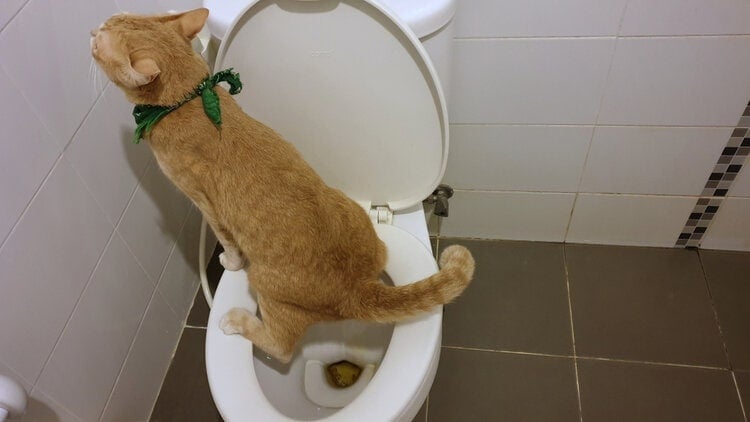Avoid Toilet Disasters: Don't Flush Cat Poop Down Your Toilet - Expert Guidance
Avoid Toilet Disasters: Don't Flush Cat Poop Down Your Toilet - Expert Guidance
Blog Article
Nearly everybody will have their personal perception on the subject of How to Dispose of Cat Poop and Litter Without Plastic Bags.

Introduction
As feline owners, it's essential to be mindful of just how we dispose of our feline buddies' waste. While it might appear convenient to flush pet cat poop down the bathroom, this practice can have damaging effects for both the atmosphere and human wellness.
Alternatives to Flushing
Luckily, there are more secure and more liable methods to deal with pet cat poop. Think about the following options:
1. Scoop and Dispose in Trash
One of the most common method of dealing with feline poop is to scoop it into an eco-friendly bag and toss it in the garbage. Make sure to utilize a committed litter inside story and take care of the waste promptly.
2. Use Biodegradable Litter
Select biodegradable feline trash made from products such as corn or wheat. These trashes are eco-friendly and can be securely disposed of in the trash.
3. Bury in the Yard
If you have a backyard, take into consideration hiding feline waste in an assigned location far from veggie gardens and water resources. Be sure to dig deep enough to avoid contamination of groundwater.
4. Install a Pet Waste Disposal System
Buy an animal garbage disposal system specifically developed for cat waste. These systems utilize enzymes to break down the waste, minimizing smell and environmental influence.
Health and wellness Risks
In addition to environmental issues, flushing pet cat waste can additionally pose wellness dangers to humans. Pet cat feces may consist of Toxoplasma gondii, a parasite that can trigger toxoplasmosis-- a potentially extreme ailment, especially for expectant females and individuals with damaged body immune systems.
Ecological Impact
Flushing feline poop introduces hazardous virus and parasites into the water, posturing a substantial threat to water environments. These impurities can negatively affect aquatic life and concession water top quality.
Verdict
Responsible family pet ownership prolongs beyond giving food and shelter-- it likewise entails proper waste administration. By avoiding purging cat poop down the bathroom and selecting different disposal methods, we can reduce our ecological footprint and shield human wellness.
Why Can’t I Flush Cat Poop?
It Spreads a Parasite
Cats are frequently infected with a parasite called toxoplasma gondii. The parasite causes an infection called toxoplasmosis. It is usually harmless to cats. The parasite only uses cat poop as a host for its eggs. Otherwise, the cat’s immune system usually keeps the infection at low enough levels to maintain its own health. But it does not stop the develop of eggs. These eggs are tiny and surprisingly tough. They may survive for a year before they begin to grow. But that’s the problem.
Our wastewater system is not designed to deal with toxoplasmosis eggs. Instead, most eggs will flush from your toilet into sewers and wastewater management plants. After the sewage is treated for many other harmful things in it, it is typically released into local rivers, lakes, or oceans. Here, the toxoplasmosis eggs can find new hosts, including starfish, crabs, otters, and many other wildlife. For many, this is a significant risk to their health. Toxoplasmosis can also end up infecting water sources that are important for agriculture, which means our deer, pigs, and sheep can get infected too.
Is There Risk to Humans?
There can be a risk to human life from flushing cat poop down the toilet. If you do so, the parasites from your cat’s poop can end up in shellfish, game animals, or livestock. If this meat is then served raw or undercooked, the people who eat it can get sick.
In fact, according to the CDC, 40 million people in the United States are infected with toxoplasma gondii. They get it from exposure to infected seafood, or from some kind of cat poop contamination, like drinking from a stream that is contaminated or touching anything that has come into contact with cat poop. That includes just cleaning a cat litter box.
Most people who get infected with these parasites will not develop any symptoms. However, for pregnant women or for those with compromised immune systems, the parasite can cause severe health problems.
How to Handle Cat Poop
The best way to handle cat poop is actually to clean the box more often. The eggs that the parasite sheds will not become active until one to five days after the cat poops. That means that if you clean daily, you’re much less likely to come into direct contact with infectious eggs.
That said, always dispose of cat poop in the garbage and not down the toilet. Wash your hands before and after you clean the litter box, and bring the bag of poop right outside to your garbage bins.
https://trenchlesssolutionsusa.com/why-cant-i-flush-cat-poop/

I ran across that write up on Don’t flush cat feces down the toilet when browsing on the web. Sharing is nice. One never knows, you might be helping someone out. Kudos for your time. Kindly visit our blog back soon.
Click Here Report this page